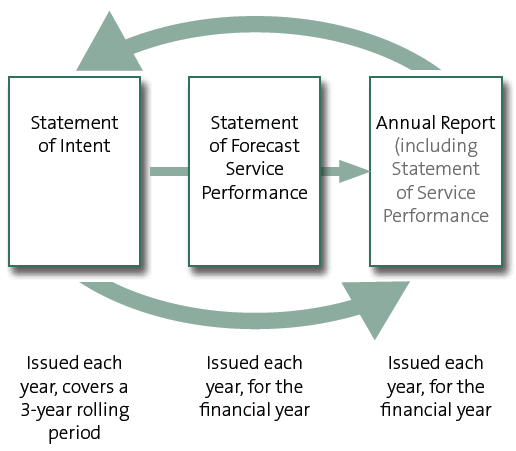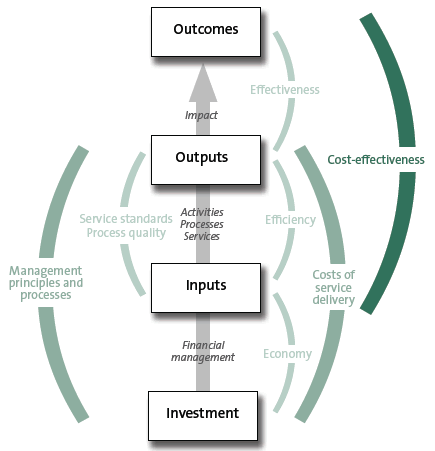Part 2: Legislative requirements and the use of annual reports
Who uses performance reports?
2.1
The annual report is one of the ways a public entity discharges its accountability to Parliament and the public. According to the Treasury, an annual report:
… is the key resource for the financial review of the performance and current operations of each department conducted by select committees under the Standing Orders of the House of Representatives.2
2.2
We consider that annual reports also serve a much wider purpose, providing information to people seeking information about public entities, their services, and their potential as an employer or as a customer. An annual report is an important tool for entities to promote what they do, how they deliver their services, and the value they provide to people.
2.3
Because different readers have different needs and expectations, the information in annual reports is unlikely to meet all their requirements.
What does the legislation require?
2.4
The PFA and CEA set out the requirements for an entity's planning and reporting documentation. The Acts require, within the main planning and reporting documents that an entity produces:
- the forecasts (contained in the Statement of Intent and the forecast Statement of Service Performance (SSP) and, for government departments, the Information Supporting the Estimates); and
- actual performance delivered (contained in the SSP in the annual report).
2.5
Figure 1 outlines these links.
Figure 1
Cycle of public entity accountability documents for public entities

2.6
The annual report should have strong links between forecast performance and actual performance. The annual report should "feed into" the next year's forecast and signal any intended changes in direction, services, or actions based on an analysis of the current year's performance.
2.7
The PFA and CEA specify the information that must be in the SSP.3 The SSP must:
- describe each class of outputs the entity proposes to supply during a financial year;
- include measures and forecast standards of output delivery for each class of outputs;
- identify the expected revenue to be earned and the proposed output expenses to be incurred for each class of outputs;
- be prepared in keeping with generally accepted accounting practice; and
- include any other measures and standards needed to assess the entity's performance at the end of a financial year.
2.8
A public entity is also required to publish the main measures and standards that it intends to use to assess and report on matters relating to its future performance, including:4
- the impacts, outcomes, or objectives the entity achieved or contributed to (including possible unintended impacts or negative outcomes);
- the cost-effectiveness of the interventions that the entity delivers or administers;
- the entity's organisational health and capability to perform its functions and conduct its operations effectively; and
- any other matters that are reasonably necessary to achieve an understanding of the entity's operating intentions and direction.
2.9
Together, these requirements provide a framework that is intended to focus performance reporting on the outcomes that an entity has sought to achieve. At a minimum, an entity should report what it delivered, the volumes of delivery, the standards to which it delivered its outputs, and how much it cost to deliver those outputs. As a result, an entity should be able to report on the impacts and the cost-effectiveness of the outputs that were used to achieve the outcomes.
2.10
Figure 2 summarises the above into an outcome-based performance management model. The model shows the relationship between different kinds of measures and what they tell us about performance.
Figure 2
Outcome-based performance management model

2.11
There has been debate in the public sector for some time about the interpretation of the specific provision about "cost-effectiveness" in the PFA. The two measures in this model that show the performance story of an entity are effectiveness and cost-effectiveness. In other words, what impact did the entity have that contributed to the desired outcome(s), were the services effective in achieving the desired result, and, in that context, did the delivered services provide value for money? Therefore, the basis for assessing cost-effectiveness is already contained in the financial and performance information required by the PFA or the CEA.
2.12
Assessing and reporting cost-effectiveness is a vital management tool. Cost-effectiveness is a result of the process of applying inputs to create outcomes. Cost-effectiveness varies over time and is influenced by external and internal events. It is an evaluation or an assessment rather than a handful of bespoke measures.
2.13
Providing information, analysis, and interpretation is important for a public entity in discharging its accountability requirements to comply with the PFA or CEA and generally accepted accounting practice. The PFA, CEA, and generally accepted accounting practice do not preclude public entities from including additional information. As a general principle, commentary should be used when necessary to provide additional contextual information that helps the user to understand the nature of the performance.5 In our view, public entities should be including this contextual information so that readers do not have to interpret the results themselves.
2.14
Therefore, we expect to see in an entity's annual report that the entity has analysed and evaluated its performance in the context of economy, efficiency, effectiveness, and cost-effectiveness. We also expect to see that the entity has honestly appraised how it has performed.
What do we expect to learn from annual reports?
2.15
An annual report should contain an analysis of performance results. Such an analysis requires having a set of appropriate measures and robust systems to collect the results, followed by procedures to analyse, interpret, and evaluate the information. At this stage, an entity can determine what actions it should take based on the analysed information.
2.16
The formal requirements in the PFA and CEA can be distilled into three main sets of information:
- Achievements – Achievements include reporting on outputs delivered, the effect the outputs had on outcomes, and comparisons with past performance.
- Value – The costs of the outputs delivered compared to what was achieved – that is, the cost-effectiveness of the outputs and the value delivered. The reader should be able to tell how this has changed over time to determine whether the entity is delivering improvements in cost-effectiveness.
- Performance interpretation – This is an explanation of the main trends during the past five to 10 years, changes that were or might be required in any aspect of the business, and results of any major management or policy decisions or operational changes made in recent years.
2.17
In a useful and effective annual report, the reader should be able to form a view on the performance of the entity and whether it is doing well and providing value for money, and read other relevant information. An entity inspires confidence and trust when it clearly demonstrates that it knows its own business, is consistently performing well, delivers value for money, and is transparent about any changes it needs to make and what it can do better.
What can we learn from the current annual reports?
2.18
Annual reports commonly include:
- A description of the entity's operating environment – This details factors or changes in the environment that might have affected the entity's performance or influenced its decisions about service delivery or operating models, and how the entity responded to them.
- A description of the achievements for the reporting year – This generally comprises an overview of activities carried out and/or completed, including any new initiatives or changes to services or service delivery methods.
- Measures against service standards (the SSP) – This sets out how the entity performed in delivering its outputs against what it had forecast and the standards it had set for each aspect. Some entities include their previous year's results alongside the current reporting year for comparison.
- Financial performance – This information is set out in keeping with the requirements of the PFA or CEA and generally accepted accounting practice, and includes the expenditure incurred in delivering each class of outputs.
- Other information – This may include, for example, organisational structures, governance structures, capability, legislation the entity administers, and a glossary of terms.
2.19
The annual report's structure is at the discretion of each public entity. It varies widely according to organisational preferences and style.
2.20
There are many examples of annual reporting practice that public entities consistently do well. However, there is a lack of good practice in measuring or evaluating impacts and outcomes (results as opposed to outputs alone), and reporting the cost-effectiveness of services or outputs, and analysing these against organisational strategies, operating models, outputs, or inputs.
2.21
We consider that, particularly in the current economic climate of little or no new investment from central government, public entities need to improve their analysis and disclosure of their performance to be clearer about their service delivery decisions.
2: The Treasury (2010), Preparing the Annual Report – Technical and Process Guide for Departments.
3: Section 41 of the PFA. The CEA specifies similar requirements in section 142.
4: Section 40 of the PFA. The CEA specifies similar requirements in section 141.
5: New Zealand Institute of Chartered Accountants (2007), Technical Practice Aid No. 9: Service Performance Reporting, paragraph 7.16.
page top